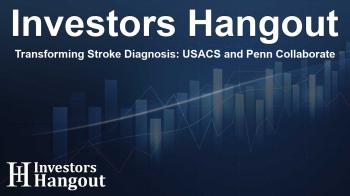Transforming Stroke Diagnosis: USACS and Penn Collaborate

Collaboration Between US Acute Care Solutions and University of Pennsylvania
US Acute Care Solutions (USACS) is excited to share its collaboration with the University of Pennsylvania Health System to enhance stroke diagnosis and prevent misdiagnosis. This partnership emphasizes the incorporation of an innovative tool within Philadelphia’s emergency departments to improve patient outcomes.
The dizziNIHSS Initiative
The collaboration focuses on the implementation of the USACS "dizziNIHSS" initiative. This program is designed to improve the diagnostic process for posterior strokes, which are often misidentified. The initiative encourages health professionals to employ the NIH Stroke Scale (NIHSS), conduct tests for skew, and assess gait in patients presenting dizziness or balance issues.
Addressing the Challenge of Posterior Strokes
Posterior strokes can be elusive, frequently going unnoticed—missed in a significant number of cases. Such cases do not exhibit classic stroke symptoms such as weakness or speech difficulties, which often leads to misdiagnosis. Instead, these strokes may be mistaken for conditions like vertigo or psychiatric disorders. The importance of early detection cannot be overstated; the phrase "time is brain" underscores the critical need for immediate treatment to prevent devastating consequences.
Importance of NIHSS
What makes NIHSS a vital tool in stroke diagnosis? This assessment method has several key advantages:
- NIHSS is often more effective than imaging techniques like CT and MRI for identifying strokes in their early stages.
- It can be administered promptly by any trained clinician, easily integrated into various medical settings without specific resource constraints, and is efficient as it only takes minutes to complete.
- This approach is cost-free, providing essential patient value while optimizing clinical workflows and resources.
Positive Outcomes from Implementation
Since its launch, the dizziNIHSS initiative has significantly improved stroke diagnosis practices within USACS-staffed emergency departments. The utilization of NIHSS has risen dramatically from 17% to an impressive 73% for patients exhibiting atypical neurological symptoms. This advancement indicates that patients treated by USACS clinicians now have significantly better odds—up to four times greater—of receiving timely and accurate stroke diagnoses.
Voices of Leadership
Dr. Amer Aldeen, Chief Medical Officer of USACS, highlighted the initiative’s potential. "The dizziNIHSS program exemplifies our mission to prioritize patient care," he stated. This endeavor not only benefits the health of individuals but also demonstrates the power of collaboration between USACS and prestigious institutions like Penn Medicine.
Commitment to Improved Diagnosis
Dr. Benjamin Sun, Professor and Chair of Emergency Medicine at Penn, expressed enthusiasm for the partnership. "This collaboration to explore the dizziNIHSS method reinforces our commitment to accurate and early stroke diagnosis for all patients. The focus on both anterior and posterior strokes is crucial for comprehensive care," he remarked.
In parallel, Dr. Jenice Baker, Chair of Emergency Medicine at Pennsylvania Hospital, emphasized the significance of ensuring critical assessments never go overlooked, indicating the alignment of both organizations’ missions towards patient safety.
Conclusion: About USACS
USACS stands as a leader in integrated acute care, tailored to meet the needs of emergency medicine, hospitalist, and critical care services. Founded by dedicated physicians throughout the country, the organization is entirely physician-owned, fostering a unique approach to patient care. USACS treats around ten million patients annually and operates over 400 programs, collaborating with numerous leading health systems to ensure quality care. For information on their services, please visit usacs.com.
Frequently Asked Questions
What is the dizziNIHSS initiative?
The dizziNIHSS initiative is a collaboration focused on enhancing the diagnosis of posterior strokes in emergency departments.
Why are posterior strokes hard to diagnose?
Posterior strokes can be misidentified due to atypical symptoms that differ from the more recognized signs of stroke.
How does NIHSS aid in stroke diagnosis?
NIHSS is a quick and effective assessment tool that helps identify strokes early, even in patients with less common symptoms.
What improvements have been seen with the dizziNIHSS initiative?
Since its implementation, the use of NIHSS has increased from 17% to 73% in relevant cases, significantly enhancing stroke diagnosis reliability.
What does USACS specialize in?
USACS specializes in integrated acute care, including emergency medicine, hospitalist services, and critical care, serving millions of patients each year.
About Investors Hangout
Investors Hangout is a leading online stock forum for financial discussion and learning, offering a wide range of free tools and resources. It draws in traders of all levels, who exchange market knowledge, investigate trading tactics, and keep an eye on industry developments in real time. Featuring financial articles, stock message boards, quotes, charts, company profiles, and live news updates. Through cooperative learning and a wealth of informational resources, it helps users from novices creating their first portfolios to experts honing their techniques. Join Investors Hangout today: https://investorshangout.com/
Disclaimer: The content of this article is solely for general informational purposes only; it does not represent legal, financial, or investment advice. Investors Hangout does not offer financial advice; the author is not a licensed financial advisor. Consult a qualified advisor before making any financial or investment decisions based on this article. The author's interpretation of publicly available data shapes the opinions presented here; as a result, they should not be taken as advice to purchase, sell, or hold any securities mentioned or any other investments. The author does not guarantee the accuracy, completeness, or timeliness of any material, providing it "as is." Information and market conditions may change; past performance is not indicative of future outcomes. If any of the material offered here is inaccurate, please contact us for corrections.
